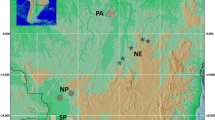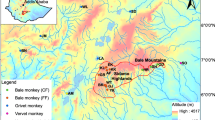Abstract
Human overpopulation, deforestation, invasion of agricultural areas, and livestock are the primary causes for population fragmentation of wildlife. The distribution range of species of the genus Macaca is constantly decreasing and becoming increasingly fragmented due to forest deterioration. Assamese macaques (M. assamensis) are classified as near threatened in the International Union for Conservation of Nature (IUCN) Red List of Threatened Animals (2008) and have been declared a protected wildlife animal according to Wildlife Preservation and Protection Act, B.E.2535 (1992) of Thailand. As studies of the population history and genetic diversity of Assamese macaques in Thailand are currently lacking, we aimed at a first investigation of their genetic diversity based on mitochondrial DNA [hypervariable regions 1 and 2 (HV1, HV2) and cytochrome B (CYTB) regions], as well as 15 microsatellite markers of five sampling sites distributed across Thailand. Our results indicate that Assamese macaques in Thailand are diverse, with eight maternal haplotypes and a low inbreeding coefficient in the Phu Khieo Wildlife Sanctuary (PKWS) population. Moreover, our phylogenetic and median-joining network analysis based on mitochondrial (mt)DNA suggests a population distribution in accordance with the evolutionary scenario proposed for M. sinica. Today, the population of Assamese macaques is fragmented, and conservation strategies are needed to ensure the maintenance of genetic diversity of this primate species.



Similar content being viewed by others
References
Acevedo-Whitehouse K, Gulland F, Grieg D, Amos W (2003) Inbreeding: disease susceptibility in California sea lions. Nature 422:35
Arandjelovic M, Guschanski K, Schubert G, Harris TR, Thalmann O, Siedel H, Vigilant L (2009) Two-step multiplex polymerase chain reaction improves the speed and accuracy of genotyping using DNA from noninvasive and museum samples. Mol Ecol Resour 9:28–36
Bandelt HJ, Forster P, Röhl A (1999) Median-joining networks for inferring intraspecific phylogenies. Mol Biol Evol 16:37–48
Borries C, Larney E, Kreetiyutanont K, Koenig A (2002) The diurnal primate community in a dry evergreen forest in Phu Khieo Wildlife Sanctuary, Northeast Thailand. Nat Hist Bull Siam Soc 50:75–88
Chakraborty D, Ramakrishnan U, Panor J, Mishra C, Sinha A (2007) Phylogenetic relationships and morphometric affinities of the Arunachal macaque, Macaca munzala, a newly described primate from Arunachal Pradesh, northeastern India. Mol Phyl Evol 44:838–849
Charpentier M, Hossaert-McKey M, Wickings EJ, Peignot P (2005a) Consequences of a one-male harem reproductive system and inbreeding in a captive group of Cercopithecus solatus. Int J Primatol 26:697–710
Charpentier M, Setchell JM, Prugnolle F, Knapp LA, Wickings EJ, Peignot P, Hossaert-McKey M (2005b) Genetic diversity and reproductive success in mandrills (Mandrillus sphinx). Proc Natl Acad Sci USA 102:16723–16728
Charpentier M, Setchell JM, Prugnolle F, Wickings EJ, Peignot P, Balloux F, Hossaert-McKey M (2006) Life history correlates of inbreeding depression in mandrills (Mandrillus sphinx). Mol Ecol 15:21–28
Charpentier MJE, Widdig A, Alberts SC (2007) Inbreeding depression in non-human primates: a historical review of methods used and empirical data. Am J Primatol 69:1–17
Choudhury A (1998) Pere David’s Macaque discovered in India. The Rhino Foundation for Nat. NE India Newsletter 2:7
Constable JL, Ashley MV, Goodall J, Pusey AE (2001) Noninvasive paternity assignment in Gombe chimpanzees. Mol Ecol 10:1279–1300
Delson E (1980) Fossil macaques, phyletic relationships and a scenario of deployment. In: Lindburg DG (ed) Macaques: studies in ecology, behavior and evolution. Van Nostrand Reinhold, New York, pp 10–30
Espoti MD, De Vries S, Crimi M, Ghelli A, Patarnello T, Mayer A (1993) Mitochondrial cytochrome b: evolution and structure of the protein. Biocimica et Biophysica Acta 1143:243–271
Fa JE, Lindburg R (1996) Population management and viability of the Gibraltar Barbary macaques. In: Fa JE, Lindburg DG (eds) Evolution and ecology of macaques societies. Cambridge University Press, London, pp 235–262
Fooden J (1982) Ecogeographic segregation of macaque species. Primates 23:574–579
Fooden J (1982a) Taxonomy and evolution of the Sinica group of macaques: 3. Species and subspecies accounts of Macaca assamensis. Fieldiana Zool new ser no. 10
Fooden J (1988) Taxonomy and evolution of the Sinica group of macaques: 6. Interspecific comparisons and synthesis. Fieldiana Zool new ser 45
Fu YX (1997) Statistical tests of neutrality of mutations against population growth, hitchhiking, and background selection. Genetics 147:915–925
Goudet J (1995) FSTAT (Version 1.2): a computer program to calculate F-statistics. J Hered 86:485–486
Goudet J (2001) FSTAT, a program to estimate and test gene diversities and fixation indices (Version 2.9.3). Available from http://www.unil.ch/izea/softwares/fstat.html
Groves CP (2001) Primate taxonomy. Smithsonian Institution, Washington DC
Kawamoto Y, Aimi M, Wangchuk T, Sherub (2006) Distribution of Assamese macaques (Macaca assamensis) in the inner Himalayan region of Bhutan and their mtDNA diversity. Primates 47:388–392
Kocher TD, Wilson AC (1989) Sequence evolution of mitochondrial DNA in humans and chimpanzees: control region and a protein-coding region. In: Osawa S, Honjo T (eds) Evolution of life: fossils, molecules and culture. Springer, Tokyo, pp 391–413
Lawler RR, Richard AF, Riley MA (2003) Genetic population structure of the white sifaka (Propithecus verreauxi verreauxi) at Beza Mahafaly Special Reserve, southwest Madagascar (1992–2001). Mol Ecol 12:2307–2317
Li QQ, Zhang YP (2005) Phylogenetic relationships of the macaques (Cercopithecidae: Macaca), inferred from mitochondrial DNA sequences. Biochem Genet 43:375–386
Malaivijitnond S, Hamada Y (2008) Current situation and status of long-tailed macaques (Macaca fascicularis) in Thailand. Nat Hist J of Chulalongkorn Univ 8:185–204
Malaivijitnond S, Varavudhi P (2002) The last possible troop of semi-wild rhesus macaque (Macaca mulatta) in Thailand. Nat Hist J of Chulalongkorn Univ 2:59–61
Malaivijitnond S, Hamada Y, Varavudhi P, Takenaka O (2005) The current distribution and status of long-tailed macaques in Thailand. Nat Hist J of Chulalongkorn Univ Suppl 1:35–45
Malaivijitnond S, Takenaka O, Kawamoto Y, Urasopon N, Hadi I, Hamada Y (2007) Anthropogenic macaque hybridization and genetic pollution of a threatened population. Nat Hist J of Chulalongkorn Univ 7:11–23
Malaivijitnond S, Arsaithamkul V, Tanaka H, Pomchote P, Jaroenporn S, Suryobroto B, Hamada Y (2012) Boundary zone between northern and southern pig-tailed macaques and their morphological differences. Primates 53:377–389
Mandal A, Pant KP, Rout PK, Roy R (2004) Effects of inbreeding on lamb survival in a flock of Muzaffarnagari sheep. Asian Australas J Anim Sci 17:594–597
Marshall TC, Slate J, Kruuk LEB, Pemberton JM (1998) Statistical confidence for likelihood-based paternity inference in natural populations. Mol Ecol 7:639–655
Nelson JE, Krawetz SA (1992) Purification of cloned and genomic DNA by guanidinethiocyanate/isobutyl alcohol fractionation. Anal Biochem 207:362–364
Noble SJ, Chesser RK, Ryder OA (1990) Inbreeding effects in captive populations of ruffed lemurs. Hum Evol 5:283–291
Nsubuga AM, Robbins MM, Roeder A, Morin PA, Boesch C, Vigilant L (2004) Factors affecting the amount of genomic DNA extracted from ape feces and the identification of an improved sample storage method. Mol Ecol 13:2089–2094
Pattanavibool A, Dearden P (2002) Fragmentation and wildlife in montane evergreen forests, northern Thailand. Biol Conserv 107:155–164
Pocock RI (1939) Primates and Carnivora (in Part), vol. 1. Mammalia. The Fauna of British India, including Ceylon and Burma. Taylor and Francis, London, p 463
Pujolar JM, Maes GE, Vancoillie C, Volckaert FAM (2005) Growth rate correlates to individual heterozygosity in the European eel Anguilla anguilla L. Evolution 59:189–199
Raymond M, Rousset F (1995) Genepop (version 1.2): population genetics software for exact tests and ecumenicism. J Hered 86:248–249
Rozas J, Sánchez-DelBarrio JC, Messeguer X, Rozas R (2003) DnaSP, DNA polymorphism analyses by the coalescent and other methods. Bioinformatics 19:2496–2497
Schülke O, Bhagavatula J, Vigilant L, Ostner J (2010) Social bonds enhance reproductive success in male macaques. Curr Biol 20:2207–2210
Schülke O, Pesek D, Whitman BJ, Ostner J (2011) Ecology of Assamese macaques (Macaca assamensis) at Phu Khieo Wildlife Sanctuary, Thailand. J Wildl Thail 18:1–15
Sinha A, Datta A, Madhusudan MD, Mishra C (2005) Macaca munzala: a new species from western Arunachal Pradesh, northeastern India. Int J Primatol 26:977–989
Storz JF, Ramakrishnan U, Alberts SC (2002) Genetic effective size of wild primate population: influence of current and historical demography. Evolution 56:817–829
Tamura K, Dudley J, Nei M, Kumar S (2007) MEGA4: molecular evolutionary genetics analysis (MEGA) software version 4.0. Mol Biol Evol 24:1596–1599
Vigilant L, Pennington R, Harpending H, Kocher TD, Wilson AC (1989) Mitochondrial DNA sequences in single hairs from a southern African population. Proc Natl Acad Sci USA 86:9350–9354
Woodruff DS (1990) Genetic and demography in the conservation of biodiversity. J Sci Soc Thailand 16:117–132
Acknowledgments
We thank the National Research Council of Thailand (NRCT) and the Department of National Parks, Wildlife and Plant Conservation (DNP) for the permission to conduct this study and for all the support granted (permit 0004.3/3618, 0002.3/2647, 0907.1/1092). We are grateful to Kitti Kreetiyutanont, Mongkul Kumsuk, Kanjana Nitaya, and Jarupol Prabnasuk (Phu Khieo Wildlife Sanctuary) for their cooperation. We thank all Team Macaque members at Phu Khieo Wildlife Sanctuary for help with sample collection. We thank Supakarn Kaewchot, Khajornpong Nakguea, all staff members from Mae Lao Wildlife Breeding Center and Chaing Rai Provincial Livestock Office for sample collection. We thank all staff from Primate Research Unit, Department of Biology, Faculty of Science, Chulalongkorn University and the 11th protected area regional office. We thank Benchapol Lorsunyaluck from Wildlife Unit, Kasetsart University Veterinary Teaching Hospital, Kampaeng Saen Campus and Private Zoo for helping us with sample collection. We are very grateful to Linda Vigilant and Jojo Bhagavatula who developed the genetic analyses for the samples collected at PKWS. This research was supported by the Max-Planck Society, the National Geographic Society, and the German Initiative of Excellence through funds to University of Göttingen, as well as the Center of Excellence on Agricultural Biotechnology, Science and Technology Postgraduate Education and Research Development Office, Office of Higher Education Commission, Ministry of Education (AG-BIO/PERDO-CHE); and we thank the Faculty of Veterinary Medicine, Kasetsart University, Thailand.
Author information
Authors and Affiliations
Corresponding author
About this article
Cite this article
Sukmak, M., Malaivijitnond, S., Schülke, O. et al. Preliminary study of the genetic diversity of eastern Assamese macaques (Macaca assamensis assamensis) in Thailand based on mitochondrial DNA and microsatellite markers. Primates 55, 189–197 (2014). https://doi.org/10.1007/s10329-013-0388-9
Received:
Accepted:
Published:
Issue Date:
DOI: https://doi.org/10.1007/s10329-013-0388-9




